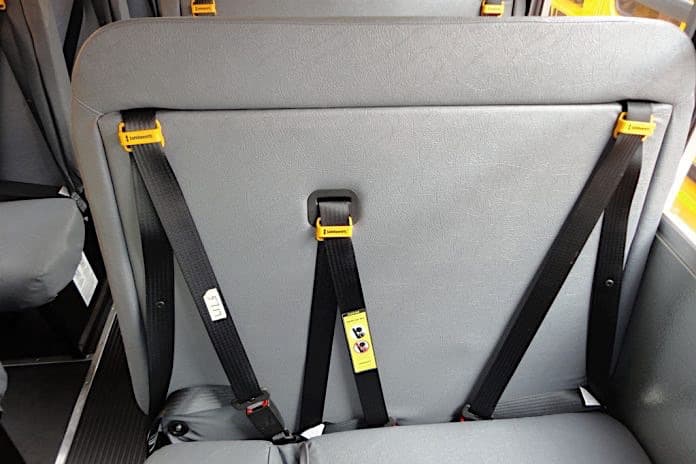In April 1977, Federal Motor Vehicle Standard 222 effectively changed the design of school bus seats, from the likes of plastic, fiberglass and low metal-backed seats to the thickly-padded seats still in use today.
 Bob PudlewskiAs a concept, compartmentalization was introduced 10 years earlier by safety researchers at UCLA. The compartmentalization seat (rule) standard without seat belt mandates took 10 years to develop from those initial test results of 1967, and it took many more years to transition into the North American fleet of school buses.
Bob PudlewskiAs a concept, compartmentalization was introduced 10 years earlier by safety researchers at UCLA. The compartmentalization seat (rule) standard without seat belt mandates took 10 years to develop from those initial test results of 1967, and it took many more years to transition into the North American fleet of school buses.
Compartmentalization in school buses has since evolved with improved seat design with high-back padded seats spaced close together, a maximum of 24 inches (61 cm) apart from front to back, and it is meant to better contain passengers in the event of a crash.
Although not an element of compartmentalization, the UCLA researchers who conducted the 1967 tests on school buses concluded that after high back seats, next in importance to school bus passenger collision safety is the use of a three-point belt, a lap belt or other form of effective restraint. That was 49 years ago!
During that period of time, we have seen many un-funded federal and/or state-mandated changes to school buses. Here’s the list of improvements:
- Foundation braking system
- Emergency exits and added roof-mounted emergency exits
- High-back seats
- Eight-way warning lights
- Stop arms
- Crossing gates
- Fuel tank crash barriers
- Reflective tape
- Ultra-low sulfur diesel engines
- Diesel emissions controls (five times)
- Automatic transmissions
- Radial tires
- Mirror system safety standards
- Joint strength integrity for school bus body construction<
- LED lights
These all are in addition to the literally dozens of differences in school bus construction standards mandated by the state agencies responsible for school transportation management.
Whether seatbelts should be a requirement remains controversial. However, should cost even be a part of the debate? Try adding up the cost impact of the above-mentioned changes over the past 40 years. The sum is literally thousands of dollars.
I do not recall any one of those changes being debated, and instead, the industry-accepted them all as safety improvements, and we adjusted our business models to accommodate the changes.
As a result, everyone including, most importantly, the students have enjoyed the benefits. Somehow we found a way.
Pudlewski is the retired vice president of fleet operations, procurement and maintenance for Laidlaw Education Services. A 40-plus year veteran of the school bus industry, he is now a private consultant as well as the technical editor for School Transportation News. He may be contacted at bpudlewski@roadrunner.com.
Related: EPA Awards Clean School Bus Grants in Several States
Related: EPA Accepting Applications for DERA School Bus Rebates Program
Related: EPA Extends Clean Diesel Tribal Grant Applications Timeline
Related: EPA Announces DERA Funding Recipients
Related: California Lower-Emission School Bus Program Issues Revisions
Related: EPA to Propose New Standard on NOx Emissions
Related: EPA Grant Brings 4 Blue Bird Electric School Buses to New York District
Related: EPA Announces Latest School Bus Rebate Awards
















